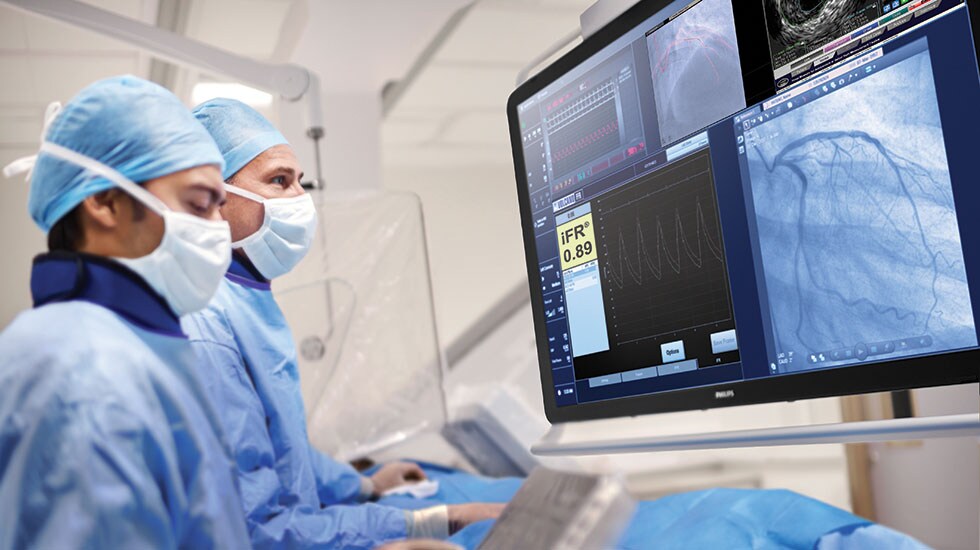When industry and physician leaders collaborate, together we can reduce cost, time and patient discomfort in treating coronary artery disease
Jun 27, 2024 | 4 minute read
About 200 million people worldwide have coronary artery disease (CAD), which occurs when the blood vessels supplying the heart are narrowed or blocked by plaque build-up [1]. Alongside visualizing the coronary arteries using X-ray images, or angiograms, clinicians can choose to carry out additional tests to assess the appropriateness of using percutaneous coronary intervention, or PCI, to treat the blockage. Using a miniaturized pressure sensor, at the end of a thin wire, the physician measures the pressure drop caused by the narrowing in the artery, which helps identify whether the patient requires medication alone or needs a stent to open the artery to improve the blood flow. Ten years ago, the standard test for measuring this pressure drop, called FFR or Fractional Flow Reserve, involved injecting a hyperemic agent – which can be expensive in parts of the world, takes time to administer (often 2-5 minutes), and can result in uncomfortable effects for the patient, including chest pain, breathlessness and anxiety.

But that all changed with instantaneous wave-free ratio (iFR) – a pressure-derived index that does not require a pharmacological agent. iFR was invented by Dr. Justin Davies from Imperial College Healthcare NHS Trust in the UK, along with the team of clinicians at Imperial College Healthcare NHS Trust and the Hospital Clinico San Carlos in Spain.
“I remember the first time a small group of us met and looked at the results of an early study and shared the excitement of seeing that this novel approach to stenosis interrogation actually worked,” said Professor Javier Escaned, Head of the Interventional Section of the Hospital Clinico San Carlos, as he recalled the early days of iFR.
iFR milestones: From validation to clinical acceptance
Those early and promising data led Philips to partner with these clinician thought leaders to validate the iFR technology as clinically safe and effective, and productize it on our fleet of IVUS & FFR machines around the world.
“For interventional cardiologists, what matters is clinical data,” says Dr. Rasha Al-Lamee, an Interventional Cardiology Consultant who was part of the Imperial team that helped to develop iFR.
DEFINE FLAIR and iFR SWEDEHEART are two of the largest landmark physiological studies, involving over 4,500 patients combined. [2,3] These studies evaluated the safety and effectiveness of iFR, demonstrating its non-inferiority to FFR. The results have been pivotal in building trust among interventional cardiologists and establishing iFR as a Class 1A recommendation in clinical guidelines, underscoring its efficacy and safety in clinical practice.
Following these studies, extensive real-world, long-term data proved that iFR enables doctors to assess CAD as effectively as the standard approach, without using hyperemic agents. This makes the process faster, cheaper, and reduces patient discomfort by more than 95%. [4]
“For patients, iFR improved the process of pressure wire assessment by removing the adverse symptoms caused by adenosine administration. For the medical community, it showed what you can achieve with partnerships between academic institutions, interventional cardiologists, and industry,” says Dr. Al-Lamee. “It’s an incredible story.”

Advancing coronary physiology with iFR and Co-registration
Partnering with clinicians on the iFR findings was only the beginning. Alongside the introduction of iFR, Philips has been part of advancing the field of coronary physiology and innovating the procedure, with the introduction of complementary technologies such as iFR Pullback and later iFR Co-registration. Today, Philips offers iFR in its unique combination of devices and imaging solutions on the interventional platform IntraSight, combined with the market leading OmniWire™ coronary pressure guide wire. When OmniWire™ is inserted into the patient’s coronary arteries, iFR Co-registration can map the iFR measurements directly onto the angiogram, enabling precise identification of significant lesions and improving PCI guidance.
The process, called co-registration, has helped to give clinicians more clinical information quickly and intuitively, compared with only using an angiogram, or the physiologic reading by itself.
“Here at Philips, we’re focused on clinical and procedural innovation to help improve experiences for physicians and patients, and to drive medical education worldwide,” explains Bert van Meurs, Philips’ Chief Business Leader of Image Guided Therapy and Precision Diagnosis.
iFR has brought new excitement in coronary physiology. It’s broadened the field of coronary physiology, and it’s brought a lot of innovation.
Partnering to build trust among clinicians
With iFR Co-registration, clinicians can not only identify whether a lesion should be treated but also pull the wire back through the vessel to assess the severity of disease along the entire vessel length. This advanced physiologic guidance helps determine not just whether to treat, but where to treat. iFR pullback, together with co-registration, provides invaluable assistance in identifying the most suitable lesion for treatment.
“I think the future of physiology is in the iFR pullback. That is an invaluable tool in identifying pressure gradients along a coronary artery that can be co-registered with the angiogram, allowing for PCI planning and post-PCI assessment,” says Dr. Allen Jeremias, Associate Director of the Cardiac Catheterization Laboratory St. Francis Hospital & Heart Center, and Member of the Cardiovascular Research Foundation, New York, U.S., who is leading a new study into the benefits of iFR Co-registration.
Today, Philips is partnering with leading institutions around the world to help identify whether iFR measurements co-registered on an angiogram can deliver superior patient outcomes and enhance the cost-effectiveness of PCI procedures. To help answer that question, Philips is currently sponsoring a global, multi-center, randomized study called DEFINE GPS including more than 3,000 participants across 100 sites worldwide.
“It's all part of an innovation journey that started with iFR,” says Andrew Tochterman, Business Category Leader for Coronary at Philips, who leads the company’s device integration for coronary interventions. “And it’s probably the best example I've seen in my career of really strong partnership between industry and clinicians, not just around the technology, but also around educating the wider healthcare community.”
Sources [1] World Health Organization
[2] Davies J.E., Sen S., Dehbi H.-M. Use of the instantaneous wave-free ratio or fractional flow reserve in PCI. N Engl J Med. 2017;376:1824–1834.
[3] Gotberg M., Christiansen E.H., Gudmundsdottir I.J. Instantaneous wave-free ratio versus fractional flow reserve to guide PCI. N Engl J Med. 2017;376:1813–1823.
[4] Gotberg M, Berntorp K, Rylance R, et al. 5 – Year outcomes of PCI guided by measurement of instantaneous wave-free ratio versus fractional flow reserve. J Am Coll Cardiol. 2022;79(10):965–974.







